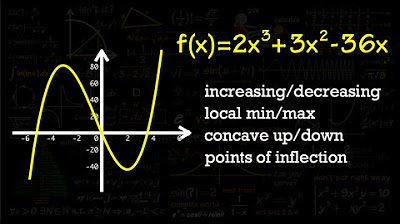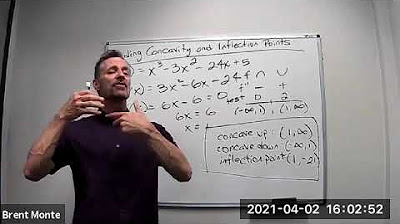Calculus I - Concavity and Inflection Points - Example 1
TLDRThis educational script demonstrates how to find the point of inflection and determine the concavity of the function f(x) = x^3 - 6x^2 - 3x + 1. It explains the process of taking the first and second derivatives, setting up a sign chart, and analyzing the second derivative to identify intervals where the function is concave up or down. The script concludes by identifying the point of inflection at (2, -21) and explaining that the function is concave up on the interval (2, ∞) and concave down on (-∞, 2). The explanation parallels the method used for finding intervals of increase and decrease, but applies to the second derivative instead.
Takeaways
- 📚 The video explains how to find the point of inflection and determine where a function is concave up or down for the function f(x) = x^3 - 6x^2 - 3x + 1.
- 📉 The concept of concavity is related to the graph of the function, where concave up corresponds to a positive second derivative and concave down to a negative second derivative.
- 🔍 To find the point of inflection, one must first find the second derivative of the function and then solve for where it equals zero.
- 📌 A point of inflection is identified where the concavity changes from up to down or vice versa, which requires the second derivative to change sign.
- 🔢 The first step in the process is to find the first derivative of the function, which is done by differentiating the original function.
- 🔄 The second step is to differentiate the first derivative to obtain the second derivative, which is crucial for analyzing concavity.
- ✂️ The second derivative is set to zero to find critical points, which are potential candidates for points of inflection.
- 📊 A sign chart is used to determine the intervals where the second derivative is positive or negative, indicating concave up or down regions.
- 📐 The domain of the function is all real numbers since it is a polynomial, so there are no restrictions on the values of x.
- 📈 The function is concave down on the interval (-∞, 2) and concave up on the interval (2, ∞) based on the sign of the second derivative.
- 📍 The point of inflection is found to be at (2, -21) by substituting x = 2 back into the original function to find the corresponding y-coordinate.
Q & A
What is the function f(x) given in the script?
-The function given in the script is f(x) = x^3 - 6x^2 - 3x + 1.
What does concavity represent in the context of the script?
-In the script, concavity refers to the curvature of the graph of the function f(x), specifically whether the graph is concave up or concave down.
What is the significance of the second derivative in determining concavity?
-The second derivative is significant because a function is concave up where the second derivative is positive and concave down where the second derivative is negative.
What is a point of inflection?
-A point of inflection is a point on the graph where the concavity changes from up to down or from down to up.
What is the first step in finding the point of inflection?
-The first step is to find the first derivative of the function to determine the intervals of increase and decrease.
How do you find the second derivative of the function?
-You find the second derivative by taking the derivative of the first derivative.
What is the process to determine where the second derivative is zero?
-You set the second derivative equal to zero and solve for x to find the critical points.
What is a sign chart and how is it used in this context?
-A sign chart is a tool used to determine the sign of the second derivative over different intervals of x. It helps to identify where the function is concave up or down.
How do you determine if there is a change in concavity at a critical point?
-You determine a change in concavity by checking if the second derivative changes sign around the critical point.
What is the point of inflection found in the script?
-The point of inflection found in the script is at x = 2, with the corresponding y-coordinate found by plugging x = 2 into the original function f(x), resulting in the point (2, -21).
What are the intervals where the function f(x) is concave up and concave down?
-The function f(x) is concave up on the interval (2, ∞) and concave down on the interval (-∞, 2).
Outlines
📚 Introduction to Concavity and Points of Inflection
The script begins with an introduction to concavity and points of inflection using the function f(x) = x^3 - 6x^2 - 3x + 1. The main goal is to find the point of inflection and determine where the function is concave up or down. The instructor emphasizes the importance of the second derivative in these determinations, explaining that a positive second derivative indicates concavity up, while a negative one indicates concavity down. The process involves calculating the first and second derivatives and then analyzing where the second derivative equals zero to find potential points of inflection. A sign chart is also introduced as a method to determine the intervals of concavity.
🔍 Analyzing the Second Derivative to Determine Concavity
This paragraph delves deeper into the process of determining the function's concavity by examining the second derivative. The second derivative is calculated, and the instructor guides through setting it equal to zero to solve for x, finding a critical point at x = 2. A sign chart is constructed to test the sign of the second derivative in intervals around this critical point. The domain of the function is noted to be all real numbers due to it being a polynomial. The instructor explains that the second derivative's sign indicates whether the function is concave up or down, with the function being concave down on (-∞, 2) and concave up on (2, ∞).
📌 Identifying the Point of Inflection and Concavity Intervals
The final paragraph focuses on identifying the exact point of inflection and summarizing the concavity intervals. The point of inflection is confirmed to be at x = 2, where the concavity changes from down to up, as indicated by the second derivative changing sign. The instructor clarifies that the point of inflection is not just the x-coordinate but also includes the corresponding y-coordinate from the original function. The y-coordinate is calculated by substituting x = 2 into the original function, resulting in the point of inflection being (2, -21). The summary concludes with the function being concave up on the interval (2, ∞) and concave down on (-∞, 2).
Mindmap
Keywords
💡Concavity
💡Point of Inflection
💡Second Derivative
💡Critical Points
💡Sign Chart
💡Continuous Function
💡Domain
💡Derivative
💡Increasing and Decreasing Functions
💡Polynomial
Highlights
The function f(x) = x^3 - 6x^2 - 3x + 1 is used to demonstrate the concept of concavity and points of inflection.
Concavity is determined by analyzing the second derivative of the function.
A function is concave up when its second derivative is positive, and concave down when negative.
A point of inflection is where the concavity changes from up to down or vice versa.
The first derivative of f(x) is calculated as 3x^2 - 6x - 3.
The second derivative of f(x) is found to be 6x - 12.
Setting the second derivative equal to zero gives x = 2 as a potential point of inflection.
A sign chart is used to determine the intervals where the function is concave up or down.
The domain of the function is all real numbers since it is a polynomial.
The second derivative is negative for x < 2, indicating the function is concave down on that interval.
The second derivative is positive for x > 2, indicating the function is concave up on that interval.
The function f(x) changes concavity at x = 2, as the second derivative changes sign from negative to positive.
The point of inflection is found to be at (2, -21) by substituting x = 2 into the original function.
The process of finding concavity and points of inflection is similar to finding intervals of increase and decrease, but involves the second derivative.
The importance of testing the sign of the second derivative at specific points to determine concavity.
The function f(x) is concave down on the interval (-∞, 2) and concave up on the interval (2, ∞).
Transcripts
Browse More Related Video

Increasing/Decreasing, Concave Up/Down, Inflection Points

Calculus I: Finding Intervals of Concavity and Inflection point

Finding Concavity and Inflection Points

Inflection Point Grade 12

Point of Inflection - Point of Inflexion - f''(x)=0 - Definition - How to Find - Worked Example 1

Learn how to determine concavity and point of inflection AP style
5.0 / 5 (0 votes)
Thanks for rating: